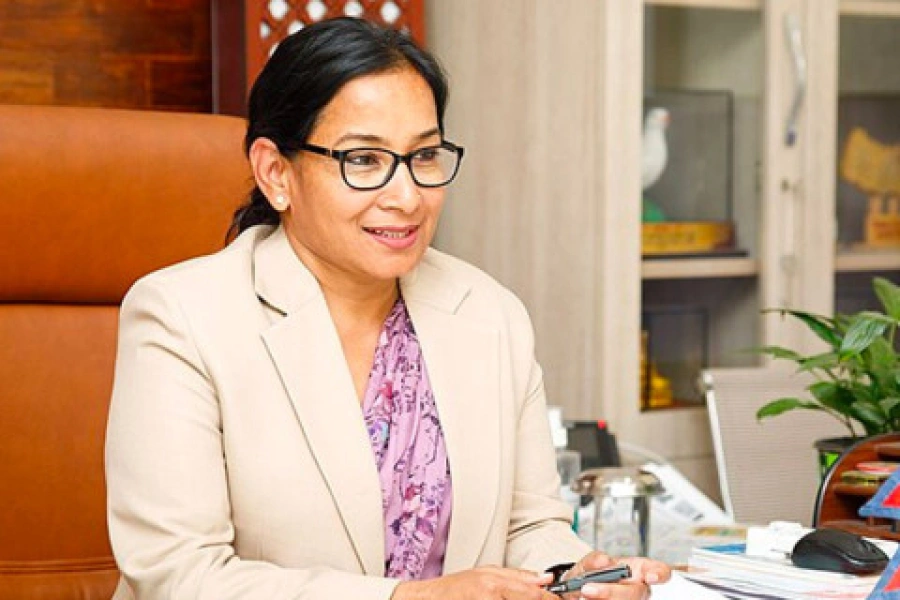Dengue is caused by a virus that is mostly transmitted by the bite of female mosquitoes of the species Aedes aegypti. Dengue fever (DF) is a mosquito-borne viral disease caused by four serotypes of the dengue virus (DENV-1, DENV-2, DENV-3, and DENV-4). Over the past 20 years, these serotypes have spread worldwide from South East Asia and are now found throughout Asia, Africa and the Americas.
DF has become a major international public health concern with an estimated 10,000 deaths and 100 million symptomatic infections per year in over 128 countries, predominantly in Asia, followed by Latin America and Africa.Dengue virus (DENV) infection is responsible for the most significant mosquito-borne viral disease in the world today.
Dengue has been identified as one of the youngest emerging infectious diseases in Nepal. The first DF case in Nepal was reported in 2004, while in 2006, a large number of probable cases and 32 laboratory-confirmed cases were reported across hospitals in central and western Terai, as well as Kathmandu during the post monsoon season. Most cases were indigenous and confirmed the presence of all 4 serotypes in Nepal. Since 2010, dengue epidemics have continued to affect lowland districts as well as mid-hill areas. This trend for increased magnitude has since continued with number of outbreaks reported each year in many districts- Chitwan, Jhapa, Parsa (2012-2013), Jhapa, Chitwan (2015-2016), Rupandehi, Jhapa, Mahottari (2017), Kaski (2018) and Sunsari (2019). In 2019, Nepal experienced a large dengue outbreak with more than 17,000 reported cases.
Dengue has been recognized as a national concern in Nepal in recent months. According to the data from the Epidemiology and Disease Control Division (EDCD), a total of 13007 dengue cases have been confirmed, the highest numbers of cases being reported from Lalitpur, followed by Kathmandu, Makwanpur, Rupandehi and Bhaktapur, as of September 15. The majority of cases have been reported during the same time period (June to Sept). In Nepal, there is a dengue outbreak, usually in an interval of 2-3 years, and the same data trend is being observed in this year as of now.
Transmission
Dengue virus (DENV) is a small single stranded RNA virus comprising four distinct Serotypes. Once infected, humans are the main carriers and multipliers of the virus, serving as a source of virus for the uninfected mosquitoes. The virus circulates in the blood of an infected person for 2-7 days, at approximately the same time that the person develops a fever. After an incubation period of 4- 10 days, infection with any of the four serotypes of the dengue virus can produce a wide spectrum of illness although most infections are asymptomatic or subclinical.
Dengue kills three people in Gandaki in three weeks

Several factors can influence the dynamics of virus transmission, including environmental and climate factors, host pathogen interactions and population immunological factors. Climate directly influences the biology of the vectors and thereby their abundance and distribution.
In Nepal, monsoon season occurs during June – August every year. The dengue season closely follows this period with seasonal cases occurring between September and November. The frequent outbreaks of DF and the rising number of dengue cases in Nepal suggest that the vector control efforts are probably ineffective or insufficient and are conducted exclusively only as part of an emergency response to outbreaks.
In the meantime, the vaccine development against DF has made remarkable progress in recent years, however, the vaccines are unavailable in Nepal and also do not protect against all serotypes of DF. Furthermore, an individual can be infected with dengue several times, which eventually increases the risk of severe dengue infection. In the absence of an efficacious vaccine and specific antiviral treatment, vector prevention and control strategies have helped to minimize the increase in dengue frequency and the severity of dengue epidemics.
Clinical and Laboratory Diagnosis
Dengue has a wide spectrum of clinical presentations. Infection with any of the 4 dengue virus serotypes results in a diverse range of symptoms, from mild undifferentiated fever to life-threatening haemorrhagic fever and shock. Early and accurate laboratory diagnosis of DENV infection is critical to effective patient management. No single diagnostic test is available to detect dengue infection across all phases of illness, thereby requiring careful selection of dengue diagnostics.
During the early stages of the disease, virus isolation, nucleic acid or antigen detection can be used to diagnose the infection. Isolation of virus from serum, plasma, peripheral blood mononuclear cells or from tissues during autopsy (liver, lungs, lymph nodes, thymus, bone marrow) and nucleic acid detection are direct diagnostic methods that are useful during the early stage of the disease. However, these tests are not regularly practiced in Nepal.
At the end of the acute phase of infection, serology is the method of choice for diagnosis. In the early stages of clinical disease, dengue can present as a mild undifferentiated “flu-like” fever with symptoms similar to those of other diseases such as influenza, measles, Zika, chikungunya, yellow fever, and malaria. Because the clinical symptoms of dengue are so diverse, accurate clinical diagnosis is challenging. As such, it is essential that laboratory or point-of-care diagnostics be used in conjunction with assessment of clinical presentation.
Rapid diagnostic tests are also available, which test for a protein produced by the virus called NS1. Use of rapid diagnostic test (RDT) kits should be rational and is discouraged to be used for each and every suspected case. However, in Nepal this is the primary method of screening the cases. NS1 Ag test is positive when patients have fever. The sensitivity of the test is the highest on the first day of fever (90%), then declines as fever days. By day 5 of fever, the test is less sensitive and may be negative from day 6 onwards. The test is more likely to be positive in primary infections than secondary.
Dengue can have several other complications during the course of the illness. Therefore, liver function tests, renal function tests, electrolytes, electrocardiography, and echocardiography should be performed in dengue patients routinely and as needed. From a public health perspective, notification of cases and health education of the public will help to prevent further infections.
Clinical diagnosis of dengue can be challenging, depending largely on what stage in the infection process a patient presents. Depending on the geographic region of the world, there can be a number of disease-causing pathogens or disease states that can mimic the disease spectrum arising from dengue infection. Dengue virus infection can result in either asymptomatic or symptomatic infection. Roughly 20% of all infections are symptomatic, with individuals experiencing disease symptoms that cover a broad clinical spectrum of non-severe to severe clinical manifestations. The initial febrile phase is characterized by rapid onset, initially with sudden high-grade fever. This phase lasts between 2 and 7 days, with the febrile phase of the disease being characterized by a facial flushing skin erythema, generalized body ache, myalgia, arthralgia, retro-orbital eye pain, photophobia, rubelliform exanthema, and headache. Sore throat, anorexia, nausea, and vomiting are also common.
The acute febrile phase may also be accompanied by hemorrhagic symptoms ranging from a positive tourniquet test and petechiae to spontaneous bleeding from the gastrointestinal tract, nose, gums, and other mucosal sites. The severity of symptoms during this phase is not a predictor of progression to severe dengue; therefore, monitoring of early warning signs needs to be undertaken during the critical phase of disease. The majority of DENV-infected patients make a full recovery after the febrile period and do not enter the critical phase of disease. However, patients that do enter the critical phase may develop warning signs that indicate increased capillary permeability leading to plasma leakage and medical attention should be followed in such cases.
During the febrile phase, liberal oral fluid administration and antipyretic treatment with paracetamol as required is recommended. Other nonsteroidal anti-inflammatory drugs should be avoided. If the patient has access to a healthcare facility nearby, he or she can be managed at home with observation of daily full blood counts. Excessive vomiting or diarrhea resulting in dehydration, severe prostration, or early bleeding manifestations are all indications for admission to hospital for close observation.
Preventive Measures
There is no vaccine currently available to prevent dengue fever. Preventing mosquito bites is the primary way to avoid the infection. Thus, spraying mosquito repellent on the skin and clothes, wearing long sleeves, long pants, and socks and avoiding being outdoors at dawn and dusk when mosquitoes are most active are the preventive protocols. Make sure to get rid of old tires, buckets, bottles, and cans, or ensure they are empty of water to reduce potential larval habitats.Chemical control should be considered as complementary to environmental management.
Dengue infection is a systemic and dynamic disease and has a wide clinical spectrum that includes both severe and non-severe clinical manifestations. The key is early recognition and understanding of the clinical problems during different phases of the disease, leading to a rational approach to case management and a good clinical outcome.





































